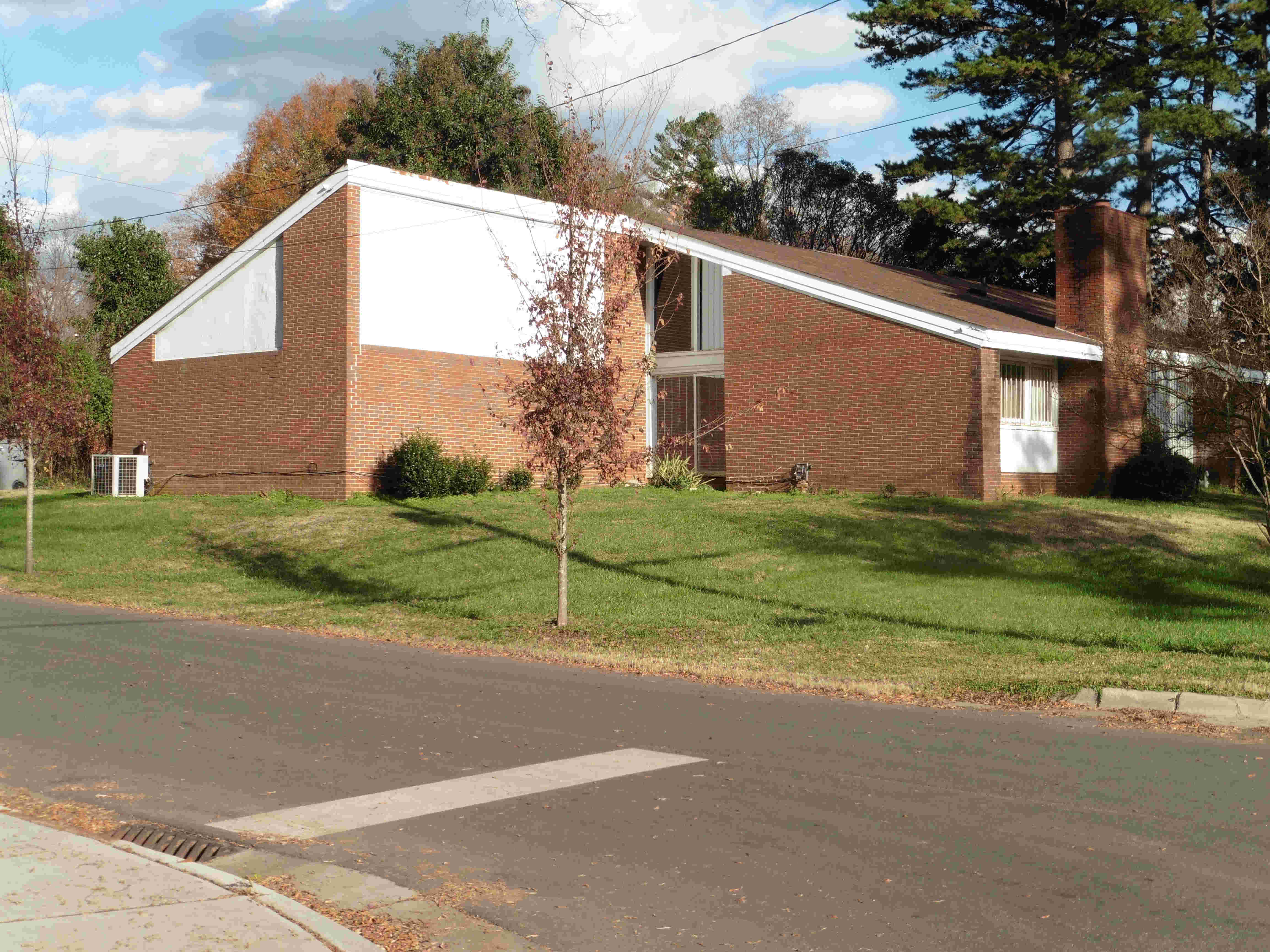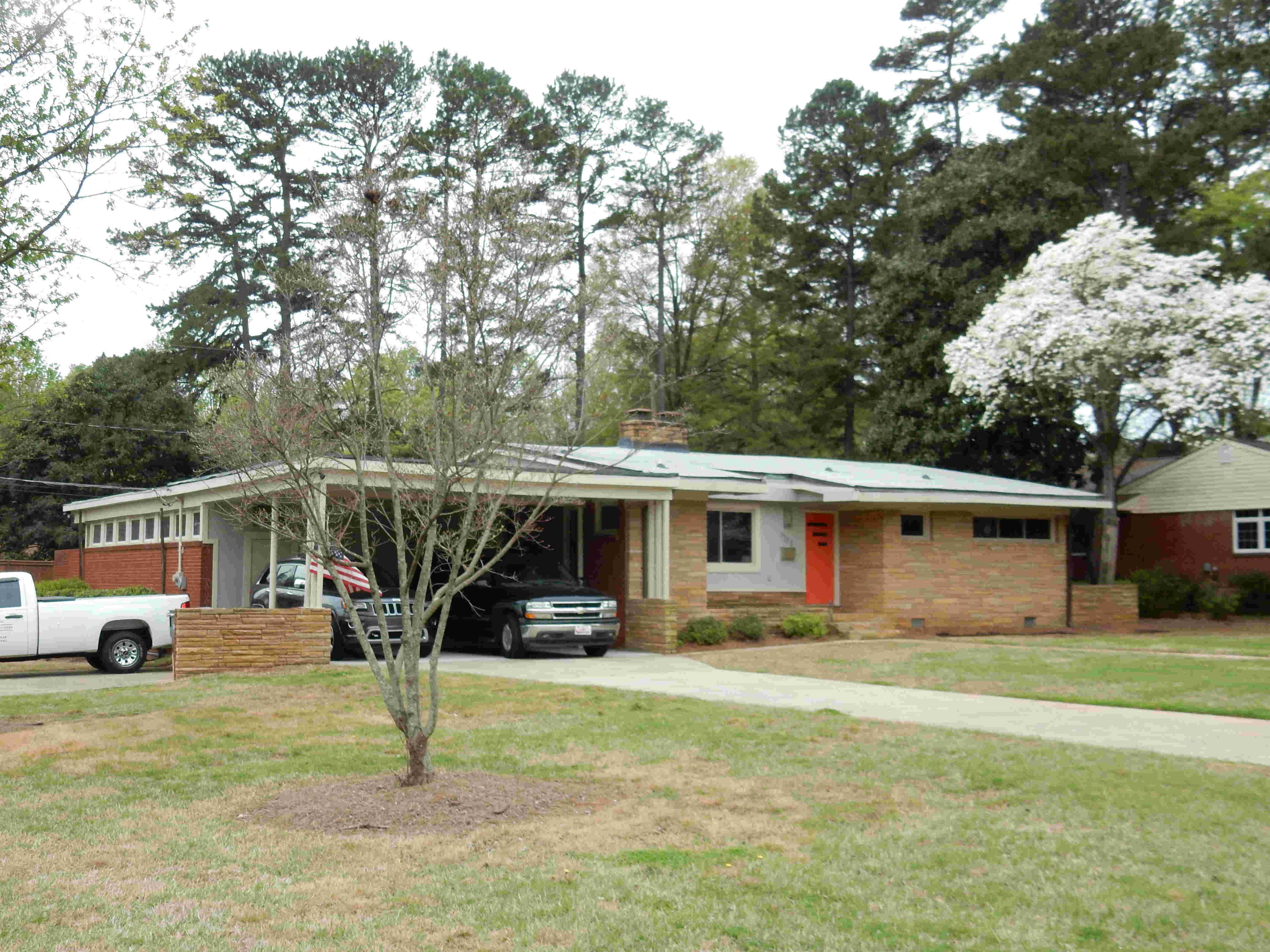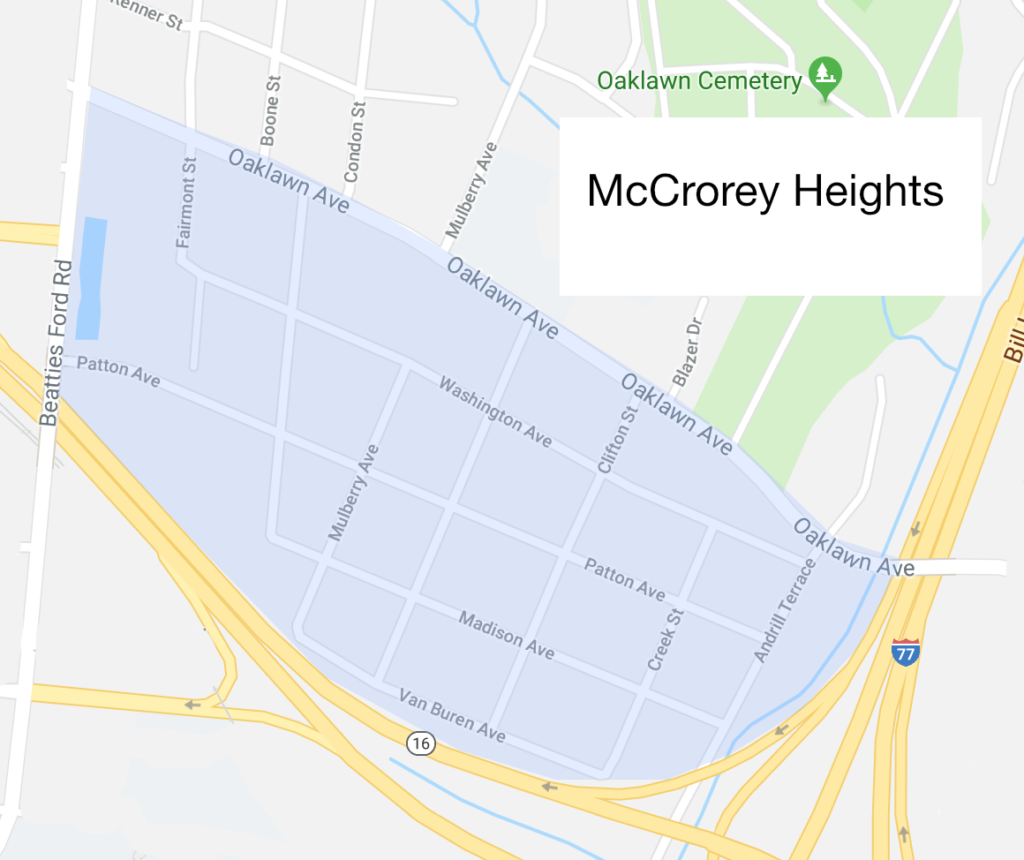McCrorey Heights:
Making History in an African American Neighborhood
Draft August 2, 2018
by Tom Hanchett, community historian
McCrorey Heights, located near historically black Johnson C. Smith University, was begun by JSCU president Rev. H.L. McCrorey in 1912, but saw most of its development between the early 1950s and early 1970s as a premier neighborhood for Charlotte’s highly educated African American elite. Many of the men and women who led important black institutions in the era of segregation lived here. As the Civil Rights Movement heated up, McCrorey Heights residents emerged as key leaders not just in Charlotte, but also regionally and nationally. Over time, the neighborhood has lost some houses along its edges but it remains remarkably intact. Today 167 dwellings, most of them custom-designed brick ranch-style houses, line its grid of straight streets — a time-capsule of mid-twentieth-century suburbia.
McCrorey Heights: Its History and Architecture
McCrorey Heights, located just north of Johnson C. Smith University off Beatties Ford Road and Oaklawn Avenue, is one of Charlotte’s most historically important neighborhoods. Founded by JCSU president Rev. H.L. McCrorey in 1912, it really took off after World War II as a development of ranch-style suburban homes for Charlotte’s African American educated elite.
Many of the men and women who built and led key black institutions in the era of segregation made their homes here. College professors and administrators resided next to school principals, ministers and entrepreneurs. Nearly every woman worked outside the home (long before that became an American norm), many as teachers and administrators in Charlotte-area schools.
The neighborhood held top religious leaders. The largest group were Presbyterians, both Charlotte ministers and also pastors who commuted to surrounding counties. Developer H.L. McCrorey, himself a Presbyterian minister, made the neighborhood a haven for people associated with Presbyterian-supported Johnson C. Smith University. That included professors and administrators – and also the headmasters of an astonishing network of Presbyterian private academies throughout the southeastern U.S., founded to give the best and brightest African American youth the educations that were denied in under-funded public schools. After Presbyterians, McCrorey Heights’s next largest religious group worshipped in AME Zion (African Methodist Episcopal Zion) churches. These included a president of the denomination’s Livingstone College in Salisbury, N.C., executives of the Charlotte-based AME Zion Publishing House, as well as several Bishops. Other McCrorey Heights residents included locally important Baptist, Methodist and Catholic ministers. The impressive campus of First Baptist Church West became a landmark on Oaklawn Avenue.
McCrorey Heights boasted nearly as many public school leaders as it did church men. These included the principals of nearly every black school in Charlotte. It is hard to grasp today how important school principals were in the era of segregation. African Americans held no management jobs in the corporate world, no management jobs in government. Being a school principal meant hiring a large staff of teachers, managing a budget and a physical plant, as well as being an educational and community leader. Even today, more than half a century after desegregation, the names of Dr. E.E. Waddell, Dr. Spencer Durant, Howard Moreland, Eddie Byers, Alexander H. Byers, Joseph Belton and others inspire tones of reverence in the voices of older black Charlotteans. School administration also was an early entry point for women into the ranks of leadership, including Dr. Gwendolyn Cunningham, Elizabeth Dargan and Lena Sammons — as well as Dr. Elizabeth Randolph, who rose from being a principal to become the CMS administrator who instituted kindergarten classes across the district, in white schools as well as black ones.
Beyond “preachers and teachers,” McCrorey Heights held a diverse array of African American upper-income families. Willie L. Johnson, Sr., resided here when he bought the Charlotte Post; the Johnson family would be the city’s leading black newspaper publishers well into the 21st century. Across the street, Romeo Alexander made his living as a real estate investor; daughter-in-law Vi Alexander Lyles would become Charlotte’s first African American female mayor in 2016. YMCA executive Edgar C. Goodwin raised money to construct the McCrorey YMCA. Jimmie and Minnie McKee ran the Excelsior Club, the elite social club in a landmark Art Moderne style building on Beatties Ford Road. Alongside the neighborhood’s white-collar professionals were highly skilled African American artisans, notably brick layers and other masonry contractors. In slavery times, most building work in the South had been handled by African Americans and that carried over into the twentieth century. Their skills in managing and budgeting, as well as in hands-on construction itself, gave them incomes that were solidly middle- or even upper-class.
As the Civil Rights Movement heated up during the 1950s, 1960s and 1970s, McCrorey Heights residents often took the lead locally and even nationally.
• Rev. J.A. Delaine, who organized the lawsuit that became Brown v. Board of Education in which the U.S. Supreme Court outlawed segregation, lived across the street from Moses Belton, a key behind-the scenes liaison with white leaders including Mayor Stan Brookshire as Charlotte’s lunchcounters and upscale restaurants desegregated in the early 1960s, ahead of many other South cities.
• Civil Rights lawyer Charles V. Bell, who sparked headlines when he sat down in a “white” bus seat years before Rosa Parks, resided two blocks from fellow attorney Thomas Wyche, who successfully sued to integrate Charlotte’s Revolution Park and Douglas Airport in the 1950s and later bailed out activists on the Freedom Ride as it came through Charlotte in 1961.
• Dr. Emery Rann, named one of the nation’s “100 Most Influential Black Americans” by Ebony Magazine in 1974 for his work desegregating hospitals and medical organizations, lived down the street from Dr. Elizabeth Schmoke Randolph, who stepped up to co-lead Charlotte Mecklenburg Schools in the wake of the U.S. Supreme Court’s landmark Swann v Mecklenburg ruling, which made Charlotte the nation’s test case for busing.
• Rowe Motley, Mecklenburg’s first black County Commissioner, could look out his picture window at the residence of William Covington, one of Charlotte’s earliest black police officers, who in turn could stand at his front door and see the home of Oren McCullough, one of the city’s first black postal carriers.
• Residents still remember the neighborhood coming together in November 1965 to help Dr. Reginald Hawkins and his family after their house was bombed in the night by an unknown assailant. Hawkins earned national notice as a strident activist who spurred the desegregation of restaurants, schools, and hospitals in Charlotte and became the first African American to run for governor in North Carolina in 1968.
Today McCrorey Heights looks much as it did in its heyday in the late 1960s and early 1970s. The rectangular grid of straight streets includes five major avenues running up from Irwin Creek: Van Buren, Madison, Patton, Washington and Oaklawn. Most of the neighborhood’s 167 dwellings front on these streets, though a few are on the short cross-streets of Andrill Terrace, Creek Street, Clifton Street, Fairfield Street, Mulberry Street, Condon Street and Fairmont Street.
Three areas have seen disruption over time.
• After he filed his plat map in 1912, Rev. McCrorey began construction in the blocks near the intersection of Beatties Ford and Oaklawn avenues, two rural roads that were already in existence. About a dozen houses on Oaklawn Avenue and adjacent blocks date from this early period. There are a number of empty lots today where early dwellings have been demolished, often because owners considered them outmoded and allowed them to fall into disrepair.
• In 1915 the city took land by eminent domain from Dr. McCrorey between Beatties Ford Road and Fairmont Avenue for construction of the Vest Water Works. Mountain Island Lake had just been created north of the city and high land was required for a station that would pump in water, purify it, and store it elevated tanks, whence it could move by gravity throughout the city. The facility is still in use today with Art Moderne concrete architecture and two large steel water towers; it is a designated Charlotte Mecklenburg Historic Landmark.
• In the early 1960s government officials announced plans for the Northwest Expressway (now Brookshire Freeway). In 1968 it bulldozed a route along the southern edge of McCrorey Heights. Houses along one side of Van Buren Avenue, plus those just completed on a hillside extension of Fairfield Avenue, were in the project’s way. Owners had house-movers transport some structures to lots elsewhere in McCrorey Heights and others to the newer upscale African American neighborhood of Hyde Park further out Beatties Ford Road, while a number fell to demolition.
Though these losses nibbled at the edges of the neighborhood, the bulk of McCrorey Heights is impressively intact. It looks much as it did half a century ago.
The predominant architectural form in McCrorey Heights is a one-story ranch house, constructed in brick. The minimal trim popular in the 1950s and 1960s sometimes has a hint of Colonial style – multi-paned windows, boxed cornices – but more often favors what is now termed “Mid-century Modern” simplicity. All of the houses appear to be custom-built and distinctive, with the exception of four look-alike dwellings on Van Buren Avenue. Interviews suggest that many residents modified plans that they had selected from magazines and newspapers. A favorite builder was Mangie McQueen, perhaps Charlotte’s busiest black residential contractor and a resident of McCrorey Heights whose daughter still resides in the neighborhood. Two structures flowed from the pen of Harvey Gantt, pioneering African American architect who desegregated South Carolina higher education when he entered Clemson University’s architecture school, and who later became Charlotte’s first black mayor in 1983. He designed the Matilda Spears house at the heart of the neighborhood and the First Baptist Church West complex on Oaklawn Avenue, both in his characteristic powerful 1970s Modernism.
Safeguarding McCrorey Heights for the future
Today McCrorey Heights is one of Charlotte’s best-preserved neighborhoods from the boom decades immediately after World War II. It is significant for its architecture, including both pre-war examples and especially post-war ranch style and related designs. It is even more significant for its history, home to numerous African American leaders in the era of segregation and in the subsequent Civil Rights movement. North Carolina’s State Historic Preservation Office has determined it to be eligible for the National Register of Historic Places. As of this writing, no other Charlotte neighborhood from the post-WWII era has yet been officially designated as an Historic District.
In the 2010s, all of Charlotte’s neighborhoods within about five miles of the center of the city are seeing extensive re-development. Individuals and speculators are buying older properties and drastically renovating or demolishing them for upscale buyers. It seems likely that this trend will have a great impact on McCrorey Heights. Historic designation – particularly a local historic district zoning overlay (option 2 described below) – can be a useful tool to give neighbors a say in how changes happen.
Neighborhood residents, led by the McCrorey Heights Neighborhood Association, might pursue two types of historic designation:
1. Become an National Register historic district listed in the National Register of Historic Places. This federal program is administered by the North Carolina SHPO (State Historic Preservation Office). The National Register safeguards against government projects that might harm historic character. But it does not regulate what individual property owners can do. There are small tax breaks available for owners who renovate properties — but only if those properties are income-producing (not private dwellings).
2. Become a local historic district under Charlotte Mecklenburg zoning. City Council makes the designation under its zoning power, administered by Charlotte Mecklenburg Planning. Residents work with Planning to draft a special zoning ordinance. It regulates what owners can do to the exterior of their property. The neighborhood can choose what to regulate; usually only major changes that are visible from the street. It is a stronger preservation tool than the National Register – but it cannot block demolition; owners retain that right, after a one-year waiting period.
If the Neighborhood Association decides to pursue either or both of those possibilities, this essay plus the detailed information about each house at https://mccrorey.historysouth.org/ will constitute most of the required documentation.
Historian Tom Hanchett is at work on a longer essay about McCrorey Heights’ history. He welcomes corrections and suggestions at Tom@HistorySouth.org.



